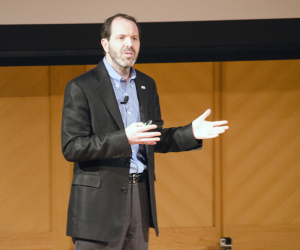
Assistant to the Administrator for Policy, Planning and Learning at the U.S. Agency for International Development, Alex Thier, confronted skepticism regarding the possibility of ending extreme poverty by 2030 during the “Ending Extreme Poverty — A Story of Trajectories and Choices” event held on Thursday in the Lohrfink Auditorium.
He spoke about the progress that has been made in the past 20 years in a discussion co-hosted by the Master of Science in Foreign Service Program, Global Human Development Program and the Mortara Center for International Studies.
Extreme poverty is defined as living on less than $1.25 a day, according to Thier. “Imagine yourself having to live — not just eat, but pay for school, pay for housing and anything else that you wanted to do — with that money,” Thier said. “But it’s not just about measure of income, it’s really about choices that people are forced to make when they live in extreme poverty. Are you going to take that quarter and pay for medicine to cure a child with illness or pay for their school fees to get basic education?”
The Global Human Development Program Director Steve Radelet recognized the sizable progress that has been made so far in fighting poverty. He said that in 1993, two billion people lived on less than $1.25 a day, but by 2011 that number had dropped to one billion. This past progress gives reason for optimism going forward, according to Radelet.
“So when you think about, ‘Well, maybe I’m a little skeptical about the potential for progress between now and 2030,’ just step back and realize how much progress has been made,” Radelet said. “And it makes you realize that achieving these goals or at least coming really close to these goals is really important.”
But despite Radelet’s optimism, a debate continues regarding the real possibility of ending extremepoverty in the world.
“What we have to ask ourselves is if it is possible,” Thier said. “And here opinions diverge. Some say that the easy places have been taken off the map and that progress is going to flat line. Others think that the dynamics of the global economy are such that the growth and the process will accelerate.”
Although there has been rapid progress in the past 20 years, it does not mean that the decreasing poverty rate is a trend that will necessarily self-perpetuate without further investment, according to Radelet.
“I do believe that there is huge potential for continued progress in the next 15 or 20 years,” Radelet said. “However, given the huge progress that has been made, I do not believe that it is inevitable or automatic that this progress is going to continue. It takes decisions, it takes sacrifice, it takes investment, it takes smart allocation of resources, it takes complete changes in direction in some countries.”
Questions of how to allocate funds coming from development agencies such as USAID also arise among a high need and a low budget, according to Radelet.
“So do you allocate your resources to where the need is greatest, but the progress might be slow and hard when that means not providing resources to other countries that maybe the need is not great but the potential for progress is bigger because they have a government in place that is making the right decisions?” Radelet asked.
With the right amount of investment and sacrifices, Thier said he believes that ending extreme poverty is a goal that can be achieved within our lifetime.
“Your generation could be the one that ends extreme poverty and I believe that that would be the greatest thing that we ever accomplish as a species,” Thier said. “And it’s within our grasp.”
Attendee Sarah Gagnon (MSFS ’14) noted the accountability factor that comes with having such ambitious goals.
“The goals that are set by the international communities are obviously very lofty and ambitious and they far exceed the monetary budget that USAID and other international development agencies have,” Gagnon said. “At the same time, I think that the goals are something that keep us accountable and keep us in check, and you know this is what we are striving for ultimately. Of course it is going to take time to get there.”














